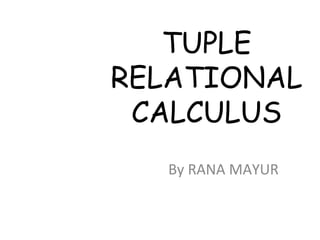
Trc final
- 1. TUPLE RELATIONAL CALCULUS By RANA MAYUR
- 2. What is TRC? • it is a calculus that was introduced by Edgar F. Codd as part of the relational model, in order to provide a declarative database-query language for this data model.
- 3. BASICS
- 4. Tuple Relational Calculus • It is a nonprocedural query language. • A query is expressed as { t | cond } • Return all tuples T that satisfy the condition Cond. • t is a tuple variable, t[A] denotes the value of tuple t on attribute A
- 5. Atoms • For the construction of the formula we will assume an infinite set V of tuple variables. • Examples of atoms are: • (t.age = s.age) — t has an age attribute and s has an age attribute with the same value • (t.name = “priyank”) — tuple t has a name attribute and its value is ”Priyank" • Book(t) — tuple t is present in relation Book.
- 6. Formulas • Formulas are combined using operators ∧ (and), ∨ (or) and ¬ (not), and we can use the existential quantifier (∃) and the universal quantifier (∀) . • Here ∃ and ∀ quantifier are called bound variable..
- 7. Predicate Calculus Formula • Set of comparison operatores: <, ≤, >, ≥ , = , ≠ • Set of connectives: and ( ^), or (v), not (¬) • Implication (=>): x => y means: if x is true, then y is true.
- 8. Predicate Calculus Formula (cont’d) • ∃ t ∈ r ( Q(t) ) ≡ There exists a tuple t in relation r such that predicate Q (t) is true • ∀ t ∈ r ( Q(t) ) ≡ Q is true for all tuples t in relation r
- 9. Formal semantics • " f1 ∧ f2 " is true if and only if " f1 " is true and " f2 " is true, • " f1 ∨ f2 " is true if and only if " f1 " is true or " f2 " is true or both are true, • " ¬ f " is true if and only if " f " is not true,
- 10. Example • student(rollNo, name, degree, year, sex, deptNo, advisor) • department(deptId, name, hod, phone) Question: Obtain the rollNo, name of all girl students in the Maths Dept (deptNo= 2)
- 11. • Answer • {s.rollNo,s.name| student(s)^ s.sex=‘F’^ s.deptNo=2} • Here student(s) is true whenever value of s is a tuple in the student relation, • false otherwise
- 12. Example Relational Schemes • student(rollNo, name, degree, year, sex, deptNo, advisor) • department (deptId, name, hod, phone) • course (courseId, cname, credits, deptNo) • enrollment (rollNo, courseId, sem, year, grade)
- 13. Example Queries • 1)Determine the departments that do not have any girl students .
- 14. • student (rollNo, name, degree, year, sex, deptNo, advisor) • department (deptId, name, hod, phone) • Answer is … • {d.name|department(d) ^ ¬(∃s)(student(s) ^ s.sex=‘F’^ s.deptNo= d.deptId)
- 15. • 2)Obtain the names of courses enrolled by student named Mahesh
- 16. Answer is … {c.name | course(c) ^ (∃s) (∃e) ( student(s) ^ enrollment(e)^ s.name = “Mahesh”^ s.rollNo= e.rollNo^ c.courseId = e.courseId}
- 17. • 3)Get the names of students who have taken at least one course taught by their advisor..
- 18. Output… • {s.name | student(s) ^ (∃e)(∃t)(enrollment(e) ^ teaching(t) ^ e.courseId= t.courseId ^e.rollNo= s.rollNo^ t.empId= s.advisor}
- 19. • 4) Display the departments whose HODs are teaching at least one course in the current semester.
- 20. Output • {d.name | department(d) ^(∃t)(teaching(t) ^t.empid= d.hod^ t.sem= ‘odd’^ t.year= ‘2012’)}
- 21. Safety of Expressions • It is possible to write tuple calculus expressions that generate infinite relations. • For example, expression { t | ¬ t ∈ r } results in an infinite relation if the domain of any attribute of relation r is infinite.
- 22. To solve this problem • We restrict the set of allowable expressions to safe expressions. • What is safe expression?
- 23. Definition of Safe Expression • An expression { t | P(t) } in the tuple relational calculus is safe if every component of t appears in one of the relations, tuples, or constants that appear in tuple relational formula P.
- 24. Example • { t | ¬ ( t ∈loan) } is NOT safe. It is possible to have a tuple t not in loan that contains values that do not appear in loan. • All examples in the previous expressions are safe.
- 25. Limitations of TRC • It can not express queries involving aggregations,closure. • It can not express non-query operations like insert,delete,update. • because those involve modeling the changes in the state of a database.
- 26. Summary • The relational calculus provides an • alternate way to express queries • • A formal model based on logical formulae and set theory • Equivalence with algebra means can use • either or both – but only one for formal • proofs
